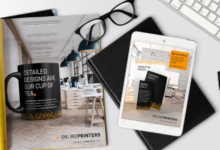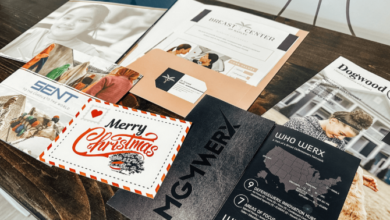How to Choose the Right Print Materials for Your Business

In today’s digital age, it can be easy to overlook the importance of print materials for businesses. However, print continues to hold significant value in the marketing and operational strategies of many successful companies. Whether you’re running a small local business or managing a large corporate enterprise, print materials remain vital for brand recognition, communication, and customer engagement. So, how do you ensure you are choosing the right print materials for your business? This guide will walk you through everything you need to know to make informed decisions that benefit your brand.
Understanding the Importance of Print Materials
Print materials play an essential role in building and maintaining a brand’s image. Physical items like business cards, brochures, flyers, and banners serve as tangible reminders of your company, helping to keep your brand top-of-mind with customers. They also convey professionalism and trustworthiness. Even in a world dominated by digital marketing, print materials can cut through the clutter and leave a lasting impression.
Selecting the right type of print material can make a big difference in how your business is perceived. Each printed item should be aligned with your company’s goals, target audience, and the message you wish to communicate.
Types of Print Materials for Businesses
When choosing print materials, it’s essential to know the variety available and how each can be used effectively. Here are some of the most common types of print materials that businesses use:
- Business Cards: Compact yet impactful, business cards are a staple for professionals. They provide your contact details and a quick introduction to your brand. A well-designed business card can leave a lasting impression after a networking event, conference, or casual meeting.
- Brochures and Flyers: Ideal for sharing detailed information about your products or services, brochures and flyers are typically handed out during events or displayed in physical locations. They’re perfect for businesses looking to provide a quick overview of their offerings.
- Posters and Banners: These large-format print materials are highly effective for promoting events, products, or services in high-traffic areas. They can grab attention quickly, making them ideal for both indoor and outdoor advertising.
- Catalogs: For businesses with an extensive range of products, catalogs serve as comprehensive guides that showcase everything you offer. Printed catalogs can complement an online store, offering customers a tactile experience as they browse through your offerings.
- Letterheads and Envelopes: Branding isn’t just about external materials. Custom letterheads and envelopes elevate your company’s professionalism in internal and external communications, reinforcing your brand with every piece of correspondence.
- Presentation Folders: When you’re meeting with potential clients or partners, presentation folders help organize all your marketing materials in a professional way. They also serve as a long-term reminder of your company.
- Direct Mail: While email campaigns are widely used, direct mail pieces like postcards, coupons, and newsletters can have a personal touch that digital channels lack. A well-crafted piece of direct mail can increase response rates and drive more engagement.
Factors to Consider When Choosing Print Materials
Selecting the right print materials for your business involves more than just picking a product. There are several factors to keep in mind to ensure that your print marketing strategy is effective.
1. Know Your Target Audience
Who are you trying to reach? Different audiences respond to different types of print materials. For example, a business targeting high-end clients might choose elegant, high-quality business cards printed on premium paper stock. On the other hand, if your target market is a younger demographic, you might opt for bold, creative flyers that are visually engaging and easy to distribute.
Understanding your audience’s preferences will help you tailor your print materials to their tastes, increasing the likelihood of making a lasting impact.
2. Define Your Objectives
Are you looking to attract new customers, promote a specific product, or reinforce your brand identity? Each print material serves a different purpose. For example, business cards help establish personal connections, while flyers are great for promoting an event or sale. Defining your objectives will help you choose the materials that align with your business goals.
3. Brand Consistency
Your print materials should reflect your brand’s visual identity. This includes your logo, color scheme, fonts, and messaging. Consistent branding across all printed materials reinforces your company’s image and makes it more recognizable to customers. Whether you’re designing business cards or banners, maintaining a cohesive look and feel ensures that your brand stands out and is remembered.
4. Budget Considerations
Budget plays a crucial role in determining which print materials you can invest in. Printing costs vary depending on factors such as paper type, size, quantity, and design complexity. However, that doesn’t mean you need to skimp on quality. Prioritize the materials that will give you the best return on investment. For instance, high-quality business cards may be worth the expense, while you can opt for simpler designs for items like flyers if they’re meant for short-term use.
5. Paper Quality and Finishing Options
The type of paper and the finishing used in your print materials can dramatically impact how your brand is perceived. A glossy finish on a brochure can give it a sleek and polished look, while a matte finish may feel more sophisticated and modern. Business cards printed on thick, high-quality paper leave a more professional impression than those on thin, flimsy stock.
The choice of finish (e.g., gloss, matte, or satin) can also affect readability and how images or text appear. Consider how the feel of the material complements your brand and the message you want to send.
6. Durability and Usability
Consider how long your printed materials need to last. For example, if you’re printing banners for an outdoor event, you’ll need materials that can withstand weather conditions. Similarly, if you’re printing menus for a restaurant, you may want to choose durable, laminated paper that can handle frequent handling and spills.
7. Environmental Impact
As more consumers become environmentally conscious, businesses are also turning to sustainable print options. Many printing companies offer eco-friendly paper made from recycled materials or sustainably sourced wood pulp. Additionally, opting for soy-based or water-based inks can reduce the environmental footprint of your print marketing materials.
Not only does this approach benefit the planet, but it can also resonate positively with customers who value sustainability. Make sure to communicate your commitment to eco-friendly practices when appropriate.
Working with a Professional Printer
Once you’ve determined the type of print materials you need, it’s important to choose a reliable printing company that can deliver high-quality products. While some small businesses may be tempted to handle printing in-house, professional printers often have access to better technology, materials, and expertise. They can also help with design elements, ensuring that your materials not only look great but also function effectively.
When selecting a printer, consider their reputation, turnaround time, and pricing. It’s also a good idea to request samples of their previous work to ensure they can meet your standards. Many printers offer customization options such as embossing, foil stamping, and die-cutting, which can add a unique flair to your print materials.
Maximizing the Impact of Your Print Materials
Once you’ve created your print materials, it’s crucial to distribute them effectively. Placement and timing play a huge role in how well your materials perform. Here are some strategies for getting the most out of your print materials:
- Strategic Placement: Place flyers or brochures in high-traffic areas, or distribute them in places where your target audience is likely to be. For example, if you’re a local restaurant, distributing flyers at nearby offices or placing menus in local hotels can attract business from a captive audience.
- Cross-Promotions: Use your print materials in conjunction with digital marketing efforts. Include QR codes on your brochures or posters that lead customers to your website, or encourage them to follow you on social media.
- Events and Trade Shows: Physical events provide an excellent opportunity to distribute print materials. Business cards, brochures, and catalogs can make lasting impressions at networking events, conferences, or trade shows where attendees can take them home.
- Direct Mail Campaigns: When done right, direct mail campaigns can have a high ROI. Personalize your materials and target a specific audience to make the campaign more impactful.
Conclusion
Choosing the right print materials for your business is a crucial step in crafting a strong brand identity and reaching your target audience. By understanding your goals, knowing your audience, and selecting quality materials, you can create effective and memorable print pieces that enhance your marketing efforts.
Don’t underestimate the power of print. When thoughtfully designed and strategically distributed, print materials can provide a lasting impression, supplement your digital marketing efforts, and drive real business growth. Investing in the right print materials today can lead to significant rewards for your business in the future.




